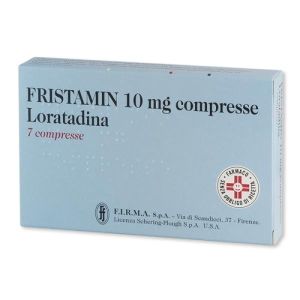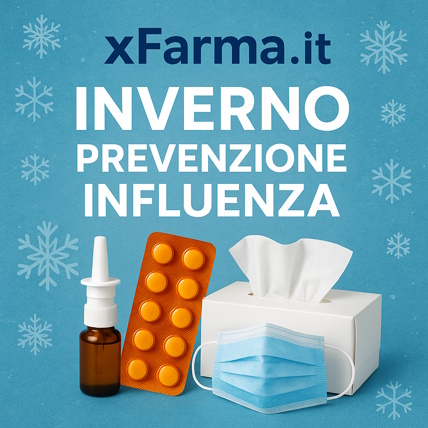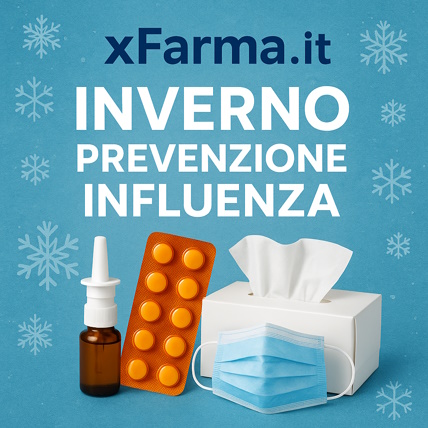Ship in Europe, Find out rates!
Language
Fristamin 10mg Loratadine 7 Tablets

Regular Price
€4.93
Special Price
€4.31
-13%
Save: €0.62
Out of stock
- box Delivery in Italy in 24/48 and free returns
- star3.000+ positive reviews
- dropboxOver 60,000 products in the catalog
NAME
FRISTAMIN 10 MG TABLETS
PHARMACOTHERAPEUTIC CATEGORY
Antihistamines - H1 antagonist.
ACTIVE PRINCIPLES
Loratadine.
EXCIPIENTS
Lactose monohydrate; cornstarch; magnesium stearate.
INDICATIONS
Symptomatic treatment of allergic rhinitis and chronic idiopathic urticaria.
CONTRAINDICATIONS / SECONDARY EFFECT
Hypersensitivity 'to the active substance or to any of the listed excipients.
DOSAGE
Adults: one tablet once a day. Children aged 6 years and over weighing more than 30 kg: one tablet once a day. For an appropriate dosage for children aged less than 6 years or weighing 30 kg or less there are other more suitable formulations. Children younger than 2 years: the safety and efficacy of the medicine have not been established. No data are available. Patients with hepatic impairment: Patients with severe hepatic impairment should be given a lower starting dose as they may have reduced clearance of loratadine. A starting dose of 10 mg every other day is recommended for adults and children weighing more than 30 kg. Patients with renal impairment: No dosage adjustments are required in patients with renal insufficiency. Elderly: No dosage adjustments are required. Method of administration: oral use. The tablet can be taken regardless of mealtimes.
STORAGE
This medicine does not require any special storage conditions.
WARNINGS
The drug should be administered with caution in patients with severe hepatic impairment. This medicine contains lactose; therefore patients with rare hereditary problems of galactose intolerance, the Lapp syndrome due to lactase deficiency or glucose-galactose malabsorption should not take this medicinal product. The administration of the medicinal product must be interrupted at least 48 hours before skin tests as antihistamines can prevent or reduce the positive reactions to the skin reactivity indices.
INTERACTIONS
Concomitant intake of the drug with alcohol does not potentiate its effects, as assessed by psychophysical performance studies. Potential interactions with all known inhibitors of CYP3A4 and CYP2D6 can occur resulting in elevated loratadine levels, which can lead to increased adverse events. Increased plasma concentrations of loratadine have been reported after concomitant use with ketoconazole, erythromycin and cimetidine in controlled clinical trials, but with no clinically significant changes (including electrocardiographic changes). Pediatric population: Interaction studies have only been performed in adults.
SIDE EFFECTS
In clinical trials conducted in adult and adolescent subjects in a number of indications, including allergic rhinitis (RA) and chronic idiopathic urticaria (CIU), at the recommended dose of 10 mg per day, adverse reactions were reported with loratadine in more than 2 percent. % compared to that of patients treated with placebo. The most common adverse reactions reported at a higher frequency than placebo were somnolence, headache, increased appetite and insomnia. Frequencies are defined as very common (> = 1/10), common (> = 1/100, <1/10), uncommon (> = 1 / 1,000, <1/100), rare (> = 1 / 10,000, <1 / 1,000), very rare (<1 / 10,000) and not known. Disorders of the immune system. Very rare: hypersensitivity reactions' (including angioedema and anaphylaxis). Pathologies of the nervous system. Very rare: dizziness, convulsions. Cardiac pathologies. Very rare: tachycardia, palpitations. Gastrointestinal disorders. Very rare: nausea, dry mouth, gastritis. Hepatobiliary disorders. Very rare: abnormal liver function. Skin and subcutaneous tissue disorders. Very rare: rash, alopecia. General disorders and administration site conditions. Very rare: tiredness. Pediatric population: In clinical trials conducted in a pediatric population of children aged 2 to 12 years, the common adverse reactions reported in excess of placebo were headache, nervousness and fatigue. The reporting of suspected adverse reactions that occur after the authorization of the drug is important, as it allows continuous monitoring of the benefit / risk ratio of the drug.
PREGNANCY AND BREASTFEEDING
Data on a large number of pregnant women exposed to the drug (over 1000 pregnancy outcomes) did not show malformative effects of fetal / neonatal toxicity by loratadine. Animal studies do not indicate direct or indirect harmful effects with respect to reproductive toxicity. As a precautionary measure, it is preferable to avoid using the product during pregnancy. Loratadine is excreted in the mother's milk. Therefore, the use of the medicine is not recommended in breastfeeding women. There are no data on fertility in men and women.
FRISTAMIN 10 MG TABLETS
PHARMACOTHERAPEUTIC CATEGORY
Antihistamines - H1 antagonist.
ACTIVE PRINCIPLES
Loratadine.
EXCIPIENTS
Lactose monohydrate; cornstarch; magnesium stearate.
INDICATIONS
Symptomatic treatment of allergic rhinitis and chronic idiopathic urticaria.
CONTRAINDICATIONS / SECONDARY EFFECT
Hypersensitivity 'to the active substance or to any of the listed excipients.
DOSAGE
Adults: one tablet once a day. Children aged 6 years and over weighing more than 30 kg: one tablet once a day. For an appropriate dosage for children aged less than 6 years or weighing 30 kg or less there are other more suitable formulations. Children younger than 2 years: the safety and efficacy of the medicine have not been established. No data are available. Patients with hepatic impairment: Patients with severe hepatic impairment should be given a lower starting dose as they may have reduced clearance of loratadine. A starting dose of 10 mg every other day is recommended for adults and children weighing more than 30 kg. Patients with renal impairment: No dosage adjustments are required in patients with renal insufficiency. Elderly: No dosage adjustments are required. Method of administration: oral use. The tablet can be taken regardless of mealtimes.
STORAGE
This medicine does not require any special storage conditions.
WARNINGS
The drug should be administered with caution in patients with severe hepatic impairment. This medicine contains lactose; therefore patients with rare hereditary problems of galactose intolerance, the Lapp syndrome due to lactase deficiency or glucose-galactose malabsorption should not take this medicinal product. The administration of the medicinal product must be interrupted at least 48 hours before skin tests as antihistamines can prevent or reduce the positive reactions to the skin reactivity indices.
INTERACTIONS
Concomitant intake of the drug with alcohol does not potentiate its effects, as assessed by psychophysical performance studies. Potential interactions with all known inhibitors of CYP3A4 and CYP2D6 can occur resulting in elevated loratadine levels, which can lead to increased adverse events. Increased plasma concentrations of loratadine have been reported after concomitant use with ketoconazole, erythromycin and cimetidine in controlled clinical trials, but with no clinically significant changes (including electrocardiographic changes). Pediatric population: Interaction studies have only been performed in adults.
SIDE EFFECTS
In clinical trials conducted in adult and adolescent subjects in a number of indications, including allergic rhinitis (RA) and chronic idiopathic urticaria (CIU), at the recommended dose of 10 mg per day, adverse reactions were reported with loratadine in more than 2 percent. % compared to that of patients treated with placebo. The most common adverse reactions reported at a higher frequency than placebo were somnolence, headache, increased appetite and insomnia. Frequencies are defined as very common (> = 1/10), common (> = 1/100, <1/10), uncommon (> = 1 / 1,000, <1/100), rare (> = 1 / 10,000, <1 / 1,000), very rare (<1 / 10,000) and not known. Disorders of the immune system. Very rare: hypersensitivity reactions' (including angioedema and anaphylaxis). Pathologies of the nervous system. Very rare: dizziness, convulsions. Cardiac pathologies. Very rare: tachycardia, palpitations. Gastrointestinal disorders. Very rare: nausea, dry mouth, gastritis. Hepatobiliary disorders. Very rare: abnormal liver function. Skin and subcutaneous tissue disorders. Very rare: rash, alopecia. General disorders and administration site conditions. Very rare: tiredness. Pediatric population: In clinical trials conducted in a pediatric population of children aged 2 to 12 years, the common adverse reactions reported in excess of placebo were headache, nervousness and fatigue. The reporting of suspected adverse reactions that occur after the authorization of the drug is important, as it allows continuous monitoring of the benefit / risk ratio of the drug.
PREGNANCY AND BREASTFEEDING
Data on a large number of pregnant women exposed to the drug (over 1000 pregnancy outcomes) did not show malformative effects of fetal / neonatal toxicity by loratadine. Animal studies do not indicate direct or indirect harmful effects with respect to reproductive toxicity. As a precautionary measure, it is preferable to avoid using the product during pregnancy. Loratadine is excreted in the mother's milk. Therefore, the use of the medicine is not recommended in breastfeeding women. There are no data on fertility in men and women.
| Destination | Cost | Detail |
|---|---|---|
| Italy | €5,90* | 24/72H |
| Austria, France, Germany, Slovenia | € 13* | 3 days |
| Belgium, Luxembourg, Portugal, Netherlands, Spain | € 14* | 4 days |
| Bulgary, Cechia, Hungary, Poland, Romania, Slovakia | € 19* | 5 days |
| Denmark, Estonia, Finland, Ireland, Lithuania, Latvia ,Sweden | € 22* | 5 days |
| United Kingdom, Switzerland, Greece, Malta/td> | € 30* | 7 days |
| Canada | € 40 | 7 Days |
European shipments with express courier: FedEx, MBE, DHL
*For the shipment outside band B ther's an extra cost of 22€ *For the shipment outside band C ther's an extra cost of 30€ Delivery Times exclude Saturday and Holidays
For Islands and Areas of difficult Accessibility the shipments are made in 72 hours and the cost will be increased by 15€
The images of the products shown on our site are purely indicative and may differ in shape, color, text and packaging shown on them. Given the difficulty of updating all the products on our site in real time or any errors, XFarma.it, all products will be identified through SKU MINSAN (code of the Ministry of Health).


